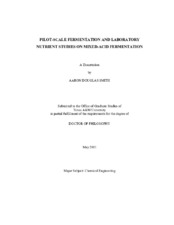| dc.description.abstract | Via mixed-culture fermentation, the MixAlcoTM produces carboxylic acids, which are chemically converted into industrial chemicals and hydrocarbon fuels.
Using pilot fermentation data, The Continuum Particle Distribution Model (CPDM) overestimated acid concentration (30–90% error) but more closely estimated conversion (<15% error). Incorporating the effect of air into the model reduced the absolute error of all predictions by >50%.
To analyze fermentation data with semi-continuous streams, the Slope method calculates the average flowrate of material from the slope of the moving cumulative sum with respect to time. Although the Slope method does not significantly improve accuracy, it dramatically reduces error compared to traditional techniques (>40% vs. <2%).
Nutrients are essential for microbial growth and metabolism. For a four-bottle fermentation train, five nutrient contacting patterns (single-point nutrient addition to Fermentors F1, F2, F3, F4, and multi-point parallel addition) were investigated. Compared to the traditional nutrient contacting method (all nutrients fed to F1), the near-optimal feeding strategies improved exit yield, culture yield, process yield, exit acetate-equivalent yield, conversion, and total acid productivity by approximately 31%, 39%, 46%, 31%, 100%, and 19%, respectively.
To estimate nitrogen concentration profiles, a segregated-nitrogen model uses separate mass balances for solid- and liquid-phase nitrogen; the nitrogen reaction flux between phases is assumed to be zero. Using five fermentation trains, each with a different nutrient contacting pattern, the model predictions capture basic behavior; therefore, it is a reasonable tool for estimating and controlling nitrogen profiles.
To determine the optimal scenario for mixed-acid fermentations, an array of batch fermentations was performed that independently varied the C/N ratio and the blend of carbohydrate (office paper) and nutrient (wet chicken manure (CM)). Reactant was defined as non-acid volatile solids (NAVS). C/N ratios were based on non-acid carbon (CNA). A blend of 93% paper and 7% wet CM (dry basis) with a C/N ratio of 37 g CNA/g N had the highest culture yield (0.21 g acidproduced/g NAVSinitial), total acid productivity (0.84 g acidproduced/(Lliq·d)), and conversion (0.43 g NAVSconsumed/g NAVSinitial). | en |


